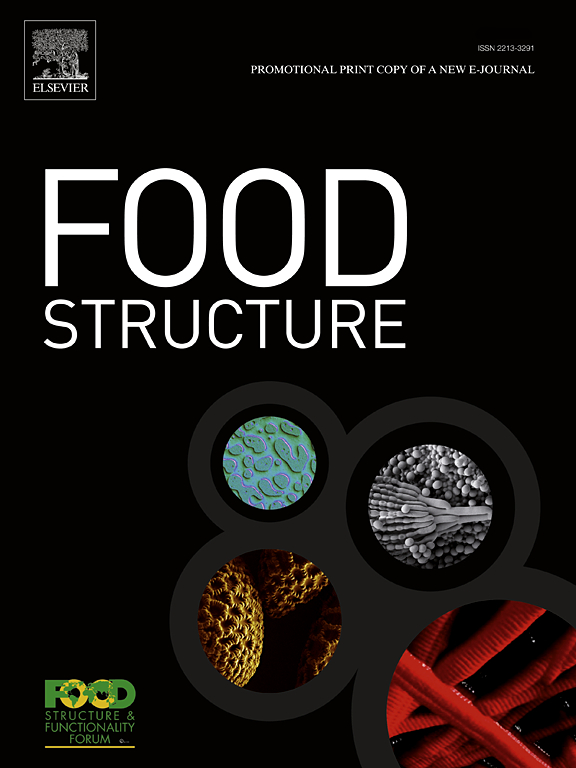Extraction and functional properties modification of guar protein isolates by ultrasound: A promising alternative protein
IF 5.9
3区 农林科学
Q1 FOOD SCIENCE & TECHNOLOGY
引用次数: 0
Abstract
This study investigated the potential of ultrasound-assisted extraction (UAE) (at 150 W, 250 W, and 350 W for 5–15 min) to isolate proteins from guar meal and its impact on structural and functional modifications of guar protein isolate (GPI). The optimized UAE treatment at 250W-10 min enhanced protein yield (14.36–16.62 %), solubility (22.27–44.55 %), foaming stability (50.95–78.77 %), emulsion activity (130.69–163.36 m2/g), and stability (26.95–56.44 min) compared with control. Surface hydrophobicity and total sulfhydryl content increased (3471–5183 and 28.90–36.76 μmol/g); while, particle size (402.5–298.36 nm) and zeta potential (–16.53 to –38.23 mV) decreased evincing significant improvements (P < 0.05) over the control. Secondary and tertiary structural alterations evident in GPI treated at 250W-10min were further validated by SEM and SDS-PAGE results. Optimized UAE treatment exhibited significantly improved protein digestibility (70.51–85.19 %) with consequently enhanced PDCAAS (44.63–52.29 %) compared to control GPI. UAE treatment did not negatively change GPI’s chemical structure ensuing 100 % cell viability in cytotoxicity assay. These findings demonstrated effectiveness of ultrasonication in enhancing GPI’s functional properties, paving way for its potential applications in human food/nutraceuticals than the current use as low value cattle feed byproduct.
瓜尔胶蛋白分离物的超声提取及功能特性改性:一种很有前途的替代蛋白
本研究探讨了超声辅助提取(UAE)(150 W, 250 W和350 W, 5-15 min)从瓜尔胶粕中分离蛋白质的潜力及其对瓜尔胶分离蛋白(GPI)结构和功能修饰的影响。优化后的UAE处理在250W-10 min下,蛋白产率(14.36 ~ 16.62 %)、溶解度(22.27 ~ 44.55 %)、发泡稳定性(50.95 ~ 78.77 %)、乳状液活性(130.69 ~ 163.36 m2/g)和稳定性(26.95 ~ 56.44 min)均较对照提高。表面疏水性和总巯基含量分别为3471 ~ 5183和28.90 ~ 36.76 μmol/g;粒径(402.5 ~ 298.36 nm)和zeta电位(-16.53 ~ -38.23 mV)降低,与对照组相比有显著改善(P <; 0.05)。在250W-10min处理下,GPI的二级和三级结构变化明显,通过SEM和SDS-PAGE结果进一步验证。与对照GPI相比,优化后的UAE处理显著提高了蛋白质消化率(70.51-85.19 %),从而提高了PDCAAS(44.63-52.29 %)。在细胞毒性试验中,UAE处理未对GPI的化学结构产生负面影响,细胞存活率为100% %。这些发现证明了超声处理在增强GPI功能特性方面的有效性,为其在人类食品/营养保健品中的潜在应用铺平了道路,而不是目前作为低价值牛饲料的副产品。
本文章由计算机程序翻译,如有差异,请以英文原文为准。
求助全文
约1分钟内获得全文
求助全文
来源期刊

Food Structure-Netherlands
Chemical Engineering-Bioengineering
CiteScore
7.20
自引率
0.00%
发文量
48
期刊介绍:
Food Structure is the premier international forum devoted to the publication of high-quality original research on food structure. The focus of this journal is on food structure in the context of its relationship with molecular composition, processing and macroscopic properties (e.g., shelf stability, sensory properties, etc.). Manuscripts that only report qualitative findings and micrographs and that lack sound hypothesis-driven, quantitative structure-function research are not accepted. Significance of the research findings for the food science community and/or industry must also be highlighted.
 求助内容:
求助内容: 应助结果提醒方式:
应助结果提醒方式:


